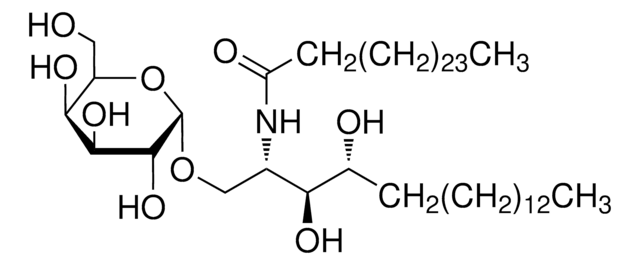SBR00023
1-Cyano-4-dimethylaminopyridinium tetrafluoroborate Ready Made Solution
organic cyanylating reagent, 100 mg/mL in acetonitrile
Sinónimos:
4-(dimethylamino)pyridin-1-ium-1-carbonitrile tetrafluoroborate, CDAP
About This Item
Productos recomendados
biological source
synthetic
assay
≥97%
form
liquid
mol wt
234.99
concentration
100 mg/mL in acetonitrile
shipped in
dry ice
storage temp.
−20°C
InChI
1S/C8H10N3.BF4/c1-10(2)8-3-5-11(7-9)6-4-8;2-1(3,4)5/h3-6H,1-2H3;/q+1;-1
InChI key
MBLVMDCQDCVKNE-UHFFFAOYSA-N
General description
Application
Biochem/physiol Actions
CDAP is considered to be a less toxic reagent as compared to cyanogen bromide (CNBr) (a known polysaccharides activator). In addition, CDAP is easier to use as it can be employed at a lower pH and has fewer side reactions. It is known that CDAP polysaccharide activation efficiency is optimal at pH 9-10. It was also reported that direct conjugation of protein to CDAP-activated polysaccharides can be performed under mildly alkaline conditions (pH 7-9). It has also been reported that proteins could also be conjugated to CDAP-activated polysaccharides at pH 5.
Features and Benefits
- Readily available solution, that reduces the need for preparation time
- Versatile and adaptable for vaccine and biochemical research
Preparation Note
Other Notes
signalword
Danger
Hazard Classifications
Acute Tox. 4 Dermal - Acute Tox. 4 Inhalation - Acute Tox. 4 Oral - Eye Irrit. 2 - Flam. Liq. 2 - Skin Irrit. 2
Storage Class
3 - Flammable liquids
wgk_germany
WGK 3
flash_point_f
35.6 °F
flash_point_c
2 °C
Certificados de análisis (COA)
Busque Certificados de análisis (COA) introduciendo el número de lote del producto. Los números de lote se encuentran en la etiqueta del producto después de las palabras «Lot» o «Batch»
¿Ya tiene este producto?
Encuentre la documentación para los productos que ha comprado recientemente en la Biblioteca de documentos.
Nuestro equipo de científicos tiene experiencia en todas las áreas de investigación: Ciencias de la vida, Ciencia de los materiales, Síntesis química, Cromatografía, Analítica y muchas otras.
Póngase en contacto con el Servicio técnico









